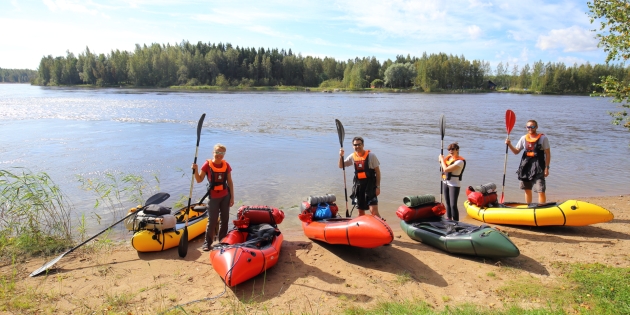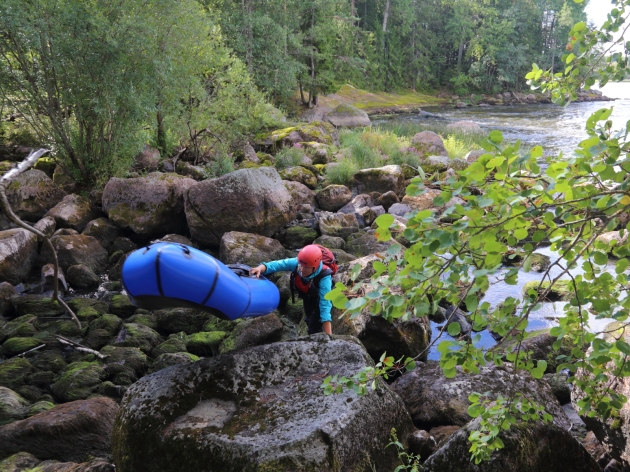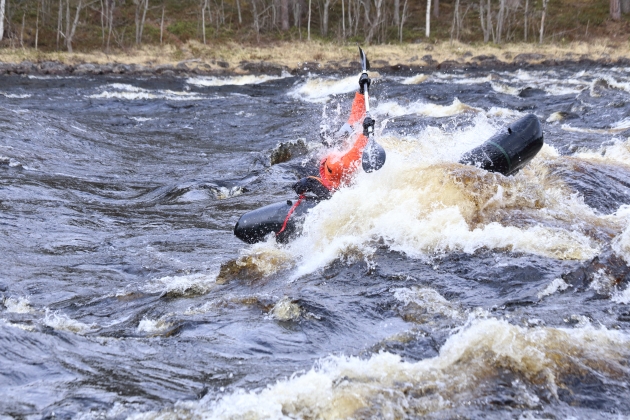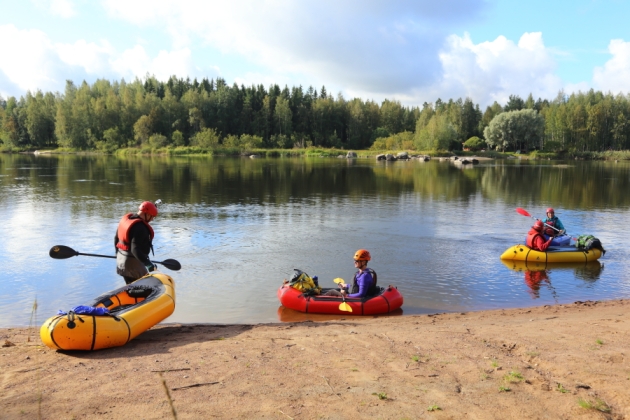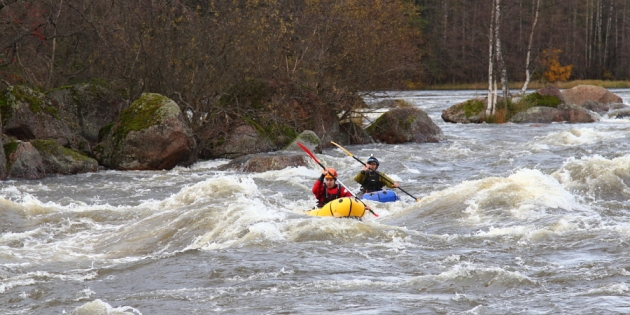The title of the post emerged from conversation in Mark’s post about Testing the Waters with borrowed Alpacka Denali Llama packraft and it’s very appropriate title for the post as this is about getting my new packraft wet and flipped around. That’s what I did the last weekend.
Friday evening in a pond

Tuomas loading his rucksack with water for some "pool training".
Mostly for the sheer fun of it but also as a training for the upcoming FPE2011 trip me and my good mate (and newly graduated wilderness guide – congratulations!) Tuomas spent the Friday evening in a pond flipping packrafts with and without load and learning to manoeuver them. Big thanks for Hendrik of Hiking in Finland for borrowing his little red Alpacka raft for Tuomas!

A freestyle kayaker playing in the Torminvirta rapid.
Pernoonkosket rapids
Of Saturday we got our rafts in the fun staff: white water at Pernoonkosket rapids in the Kymijoki river near Kotka, a bit over one hour drive from Lappeenranta where I live. I had never visited the Pernoonkosket but I think I’ll be returning there regularly from now on. There is a good description of Pernoonkosket here but it’s in Finnish so I’ll give a short summary in English.
Pernoonkosket is a 1,1 kilometer long stretch of rapids in three stages:
– The uppermost rapid is class II Torminvirta (1,4m/150m) which is also the funniest part of the system. In the beginning there is a small stopper on the river left (visible in the picture above) and smooth fast current on the right. These are followed by two big breaking waves, followed by smaller breaking cross waves from the front and left and a longish wave train in the end. There are some stones under the waves but nothing especially dangerous. The rapid is easy to portage on the gravel/stone bar on the river right.
– The second rapid is Karkuuskoski (0,8m/100m) with one big surfable wave in the beginning followed by a wave train. There is a big rock just beneath the surface so this is a bad place for a swim! This is a bit hard to portage as the small island in the middle is full of bush and there is some private property on the river right bank but a packraft can be first paddled upstream in the eddy on the right and then walked by the rocks at the neck of the rapid. After the rapid there is reasonably strong current that makes paddling a packraft upstream a bit hard but it’s still possible.
– The lowest rapids flow in three canals with the left canal, Sittaränni (1,3m/200m), is quite enjoyable with big V style wave on the right, a very firm stopper wave in the middle and a good eddy in the left, all followed by smaller waves and a bit rocky bottom. The middle canal of the lowest rapids is called Tukkiränni and there is dangerously powerful hydraulics in the end so it’s best avoided with small boats.Beneath these rapids there is a sandy beach on the river left and some good eddies before it.
– In addition to the rapids I mentioned there are smaller parallel rapids (see the map at the end of the link above). There is a free to use shed for shelter and parking area next to the Sittaränni rapid.
Saturday in the white water
So, we arrived at the rapids around midday and after changing into our wetsuits, pfds and bicycle helmets and inflating the rafts we hit the water. We paddled upstream to Karkuuskoski with some detours, rode the rapid once and played in the eddy for awhile accompanied by some freestyle kayakers. We must have been a weird sight in our rubber boats and bicycle helmets! Tuomas had a near bander snatching in the big sharp stopper wave of the Karkuuskoski but managed it with a quick high brace.

Tuomas surfing in the Sittaränni rapid.
After this we rode the Sittaränni and started to play in the stopper wave. The wave has some real power in it and hold packraft so well that it’s hard to get off from the surf! So we decided to avoid the stopper as it would have been also hard to swim out of it if capsized. We noticed that packrafts can catch and surf even small standing waves very easily – often unintended while ferrying thru the wave trains. We tried to surf the left side of the river but it was hard because of the currents (strong eddy, some rock and strong main current) and lead into what the title of the post suggests: I flipped the Llama three times there and Tuomas capsized twice. On the first times we swam a shore with the paddle and raft but in the end we managed to self-rescue with ease.

Tuomas taking a closer look at the bottom of Sittaränni.
After of playing in the Sittaränni we had a coffee break at the car parked next to the rapid and then we headed up to Torminvirta rapid. There was a group of freestyle kayakers at Torminvirta with some of them very interested about our rafts. They though packrafts would make good training tools for beginners who are afraid of capsizing in kayaks. Well, sport paddlers are likely to miss the biggest advantage of the packraft: the packability and the adventures it enables! We did several runs in the Torminvirta and some ferrying and wave catching in the wave train below it. The rapid was surprisingly easy to paddle despite the big waves. On the last run we both capsized while fooling around. I got stuck for a while in the second big wave and Tuomas was surprised by the breaking cross waves. We both managed to do quick self-rescues. It started to be a routine after playing in the Sittaränni.

Yours truly riding down the wave train below the Torminvirta rapid.
After getting enough we paddled thru Karkuuskoski and Sittaränni back to the car for a quick snack. I capsized in the Sittaräni while trying to catch a big river with too aggressive ferrying in wrong place and hitting my left hip to rocks in the bottom.

My hip after making some contact with the rocks of the Sittaränni.
After few meat pastries and coffee in the shed sheltered from the rain, we loaded our packrafts with about 15 kilo rucksacks and paddled back to Torminvirta. We did several runs and some ferrying in the waves. As predicted the packrafts tracked better with the load on the bow. Tuomas said that the older model Alpacka was much more stable in the rapids with the front load but I didn’t feel major difference in my 2011 model Llama. This is mostly because of the big butt that adds stability. We both noticed that the rafts were more sluggish and slower to respond.

Tuomas riding down the Torminvirta with rucksack on the bow.
At some point we noticed that the clock was around 6:00 pm and it was time to get back home after six hours of nearly constant white water fun. We rode down all the three rapids with no problems, catched an eddy after Sittaränni and took out. We packed the wet gear in rain, shared a last chocolate bar and started the drive back home. It was a good day: learning new things and having great time! I’m not still too confident about the big drops and long class III stretches that wait us in Lapland but I think we’ll manage. At least our self-rescue routine is already quite good.

Yours truly riding the waves in Torminvirta with rucksack keeping the bow down.
Few words about gear
– As is widely known the 2011 Llama is veeery cool boat. The new hull makes it a lot more stable. I don’t think this is very big deal in class I or II but the difference will be likely remarkable in more challenging white water. But luckily Tuomas is more experienced paddler than I am… The standard spray deck doesn’t work with “leisure boating” style pfds. It might work better with high riding white water kayaking pfds but I think I’ll be adding some velcro to the deck or getting the “Beefy spray deck” upgrade from Alpacka later. I am 186cm long and the Llama is okay for me but for playing in white water I might move the seat forward and swap the backrest into dry sack to move it along with the seat. The seat is attached with cord threaded through four tabs (two on each side) and I think that the seat would be just fine threaded more forward with just one pair of tabs. Then a bottom tab of a dry sack (e.g. Ortlieb PS17, size M or so) could be threaded to the tabs in the back of the boat and the top of the dry sack could be attached to the tie-down plates used to attach the removable backrest. This would move the paddler more forward and create a 20-30 liters of dry space for gear near the center of the gravity.
– The two part aluminum paddle from Welhonpesä performed well enough and is a good pick for the price.
– Cheap wetsuits from Motonet are very useful in colder water. The suit is not especially designed for paddling but works well enough, gives some protection from rocks while swimming and is very reasonably priced. I think I’ll add a relief zipper to mine for conveniency. Cheap neoprene socks (Snow Fox brand) work also very well and have even sealed seams! But the gloves from the same brand don’t work too well for paddling as the seams chafe.
– All the pictures are taken with Olympus Though-3000 waterproof compact camera. I don’t like it too much as a camera but it can take hits and be submerged so it fits the job well. It also takes 720p video, which will likely follow later.
Next time I’ll be trying the Llama in still water with two people and two rucksacks…
Jaakko Heikka - Professional wilderness guide and diehard outdoor enthusiast with a special interest for lightweight backpacking, arctic expeditions and outdoor photography.
